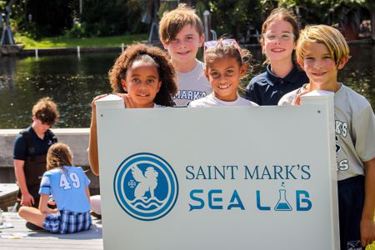South Florida Students At Saint Mark's Shine Hope On The Next Generation Of Sustainability Leaders To Help Solve Growing Water Issues

From the widely documented water crisis in Flint, Michigan, to the recent disaster that we witnessed in Jackson, Mississippi, that left over 150,000 people without water, any time there is a problem as it relates to water, it can have devastating effects on our population. On top of these infrastructure issues, there is widespread contamination, including arsenic, uranium, microplastics, and forever chemicals. Water, our most life-giving resource, needs to be at the forefront of research on how we can improve our systems and make water safer. But what may surprise you is the team of budding scientists looking to explore solutions are as young as five years old.
These bright minds are students at Saint Mark’s Episcopal School, a K-8 school based out of Fort Lauderdale, Florida, known for its waterways. The school just announced the launch of its SeaLab, an engineered tidal pool setting the standard for STEM experiential learning. The Head of School for Saint Marks shared, “First and foremost, our goal is to bring awareness of these challenges facing other communities also happening in our own backyard. These water issues will not be resolved quickly, but they are critical that we solve. We aim to challenge our students to be problem solvers now and empower them at a young age with the knowledge, tools, and guidance to move the dial on finding real solutions.”
It may appear like an out-of-the-box idea, but even industry experts agree that training the next generation of sustainability leaders is a move in the right direction. Riggs Eckelberry, a top water expert and CEO of OriginClear, a clean water innovation hub, shared, “We are facing a water crisis in this country and around the world as this resource becomes increasingly scarce and polluted. The more we educate on these issues, foster curiosity, and spark the idea that there are solutions, the better off we will all be in our world. It is amazing to see young people engaged in preserving our environment, and I believe that a real difference can be made with the right knowledge, resources, and encouragement.”
The newly launched SeaLab is a 20-by-20-foot manufactured tidal pool behind a seawall on a river basin with a two-to-three-foot tidal surge twice daily. It was created and designed with the help of Brizaga, a multi-disciplinary civil and coastal engineering firm. Holes were drilled into the wall separating the river from the tidal pool, allowing water and sea life to flow naturally in and out with the tides. An internal dock structure was built so students could access the water to conduct experiments. A curriculum and accompanying experiments were developed in collaboration with the faculty from Nova Southeastern University Halmos College of Arts and Sciences and Guy Harvey Oceanographic Research Center, and the University of Miami Rosenstiel School of Marine and Atmospheric Science.
SeaLab was born from the idea of inspiring students to be problem solvers to local sustainability challenges. Back in 2019, the Greater Fort Lauderdale business community was waking up to the effects of sea level rise but was challenged by the costly methods for seawall construction. Dr. Taintor shared, “We thought our kids could provide unique ideas for designing and testing in real tidal condition, economical sustainable seawalls, that would help our neighbors and businesses protect their property and way of life here in Fort Lauderdale and possibly beyond. From that idea, SeaLab was born.” The school hopes the SeaLab will help tackle challenges in water quality, flooding, microplastics, forever chemicals, and many other water and marine life issues.
It does not only have an impact on the environment, but there is a real economic benefit that could come from a project like SeaLab. The average cost of seawall raising or replacement in South Florida can be upwards of $1,500 to $2,000 a linear foot to bring the walls to 2050 NOAA standards. Dr. Taintor added, “If our students can develop a more economical solution, we can then partner with local cities and engineers to bring their ideas to life. Even if we conceptualized an idea to cut the costs in half, the monetary impact for families and businesses in our local community and beyond would be huge.”
SeaLab is truly a one-of-a-kind immersive learning experience that has not been done, especially in a K-8 setting. To think that students as young as five years old are being told that they can make an impact on the problems we face today is truly inspiring. Microplastics, forever chemicals, flooding, natural filters such as oyster beds, and other key issues to tackle need these young minds to start thinking about them today to solve the problems of tomorrow. Dr. Taintor shares, “If we can light that fire to exponentially develop the critical thinking skills of these young students, they can become the leaders we need to protect our way of life. If SeaLab can be the model for them and students at other schools, we have a real chance of finding solutions in our lifetime.”
Source: OriginClear
